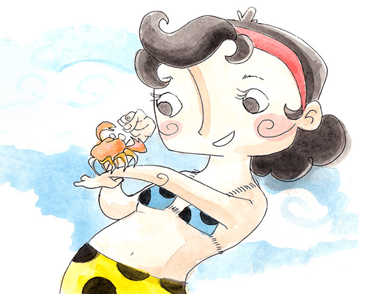Teacher's support sheet

Snow White's vacation
Snow White decided to get a vacation. She traveled to a beach in Brazil with her
Prince, Luke. But something went terribly wrong.
Are you curious to know what happened? Read the story and learn from Snow’s mistake.

Teacher’s tips
Level of education: Elementary School - Early Childhood Education
Age: 04 to 08 years old
Most children love to play in the sea, pool or on the school playground. However, a simple prank can cause serious health damage. We all need sun exposure. When skin is exposed to the sun, our bodies produce vitamin D, which helps the body absorb calcium for stronger, healthier bones. However, excessive exposure can cause injuries, burns, eye damage and even skin cancer. Taking children this information in a playful way is fundamental for them to grow up aware and with healthy habits.
Learner outcomes
Develop text reading and interpretation; Understand the use of the alphabet in the construction of words; Expand vocabulary; Stimulate the imagination; Stimulate creativity; Participate in different moments of reading; Develop attentive listening to understand texts; Develop and improve oral and written language; Read different types of short stories; Understand the importance of sunscreen; Understand that the body needs care;
Teachers’ goals
Work on reading and text interpretation skills; Provide, in a playful and creative way, the progress in the reading and writing process of children; Expand the class's repertoire of letters and words; Offer the game as a didactic resource to fix the content worked in the classroom; Awaken the habit of listening and feeling pleasure in situations involving reading; Introduce body care; Explain the importance of sunscreen; Provide contact with texts of literary quality;
Suggestions of approaches for the teacher
(Suggestion 1) Make a circle with the students and ask:
• Have you ever been to the beach?
• Did you have to take any kind of care?
• Did you play in the sun?
• Do you use sunscreen when you go out to play in the sun?
• Did you know that the sun can make you sick?
(Suggestion 2) Ask students to draw a picture of what they learned in the story.
(Suggestion 3) Ask the students to draw living beings that like the day and living beings that prefer the night.
(Suggestion 4) Cut out magazine images that refer to a day at the beach and its care.
(Suggestion 5) Ask students to build a mural about the importance of the Sun.
(Suggestion 6) Ask the students to build a wall talking about the risks that the sun in excess can cause.
(Suggestion 7) For third year students, ask them to do a survey on the risks of the sun to health.
(Suggestion 8) Show students how light behaves by placing different types of objects in front of sunlight or artificial light.
More about it
The sun emits rays of light that can help and harm us. These are known as ultraviolet (UV) rays. There are three different types of UV rays: UVA, UVB and UVC.
UVA rays are the most common form of sun exposure. UVB rays are less exposed to the sun, but they are more intense. UVC rays are the worst. Fortunately, we are not at risk from UVC rays. The Earth's ozone layer blocks these rays.
Even if you can't see UV rays, they can pass through your skin. The outer layer of the skin is the epidermis. The inner layer is called the dermis. Your nerves and blood vessels are located in the dermis. The cells of the epidermis contain a pigment (or dye) called melanin. Light-skinned people have less melanin than dark-skinned people. This is why very fair-skinned people burn more easily.
Melanin protects our skin and also creates vitamin D. When your body defends itself against UV rays, your skin tans or darkens. Excessive exposure to the sun allows UV rays to reach the inner layers of the skin.
